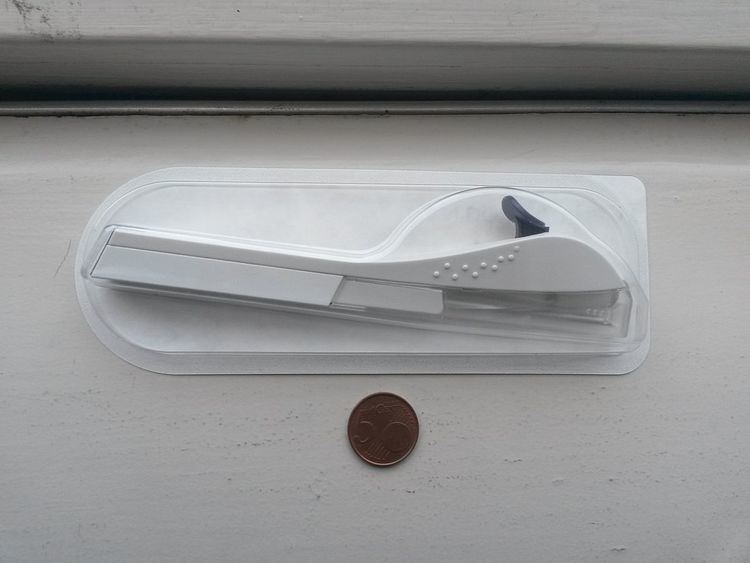 | ||
A contraceptive implant is an implantable medical device used for the purpose of birth control. The implant may depend on the timed release of hormones to hinder ovulation or sperm development, the ability of copper to act as a natural spermicide within the uterus, or it may work using a non-hormonal, physical blocking mechanism. As with other contraceptives, a contraceptive implant is designed to prevent pregnancy, but it does not protect against sexually transmitted infections.
Contents
Women
Several options exist for women, depending on the approval status of devices in their region.
Implant
The contraceptive implant is hormone-based and highly effective, approved in more than 60 countries and used by millions of women around the world. The typical implant is a small flexible tube measuring about 40mm in length and is inserted under the skin (typically in the upper arm) by a health care professional. After it is inserted it prevents pregnancy by releasing hormones that prevent ovaries from releasing eggs and thicken cervical mucous. The two most common versions are the single-rod etonogestrel implant and the two-rod levonorgestrel implant.
Brands include:
Benefits of the implant include fewer, lighter periods; improved symptoms of premenstrual syndrome; long-lasting, up to three years; smoker- and breastfeeding-safe; and the convenience of not needing to remember to use it every day. In some cases, negative side effects do occur, the most common being irregular bleeding for the first six to 12 months. Less common symptoms include change in appetite, depression, moodiness, hormonal imbalance, sore breasts, weight gain, dizziness, pregnancy symptoms, and lethargy.
Intrauterine device
An intrauterine device (IUD) is a small contraceptive device, often 'T'-shaped and containing either copper or the hormone levonorgestrel, which is implanted into the uterus. They are long-acting, reversible, and the most effective types of reversible birth control. Failure rates with the copper IUD is about 0.8% while the levonorgestrel IUD has a failure rate of 0.2% in the first year of use. Among types of birth control they, along with birth control implants, result in the greatest satisfaction among users. As of 2011, IUDs are the most widely used form of reversible contraception worldwide. IUDs also tend to be one of the most cost-effective methods of contraception for women.
Men
Several barriers exist to expanding research into implantable and other contraceptive methods for men, including vague regulatory guidelines, long device development timelines, men's attitudes towards convenience, and a significant lack of funding. Several implantable devices have been attempted, both hormonal and non-hormonal.
Research
In 2001, Dutch pharmaceutical company Organon announced clinical trials of its implantable etonogestrel-based male contraceptive would begin in Europe and the U.S., anticipating a marketable product as early as 2005. Despite promising results, research development stopped, with outside speculation that lack of marketability was a factor. Organon representative Monique Mols stated in 2007 that "[d]espite 20 years of research, the development of a [hormonal] method acceptable to a wide population of men is unlikely." Schering/Bayer had been working on a similar annual implant with quarterly injections but cancelled the research in 2006/2007, declaring that men would most likely view it as "not as convenient as a woman taking a pill once a day."
In 2005, a collaboratory project led by the Population Council, the University of California, Los Angeles, and the Medical Research Council began researching a matchstick-sized implant that contains MENT (7α-methyl-19-nortestosterone or Trestolone), a "synthetic steroid that resembles testosterone." Clinical trials were set to begin in 2011 or 2012, and the project was ongoing as of 2016, with hopes of gaining approval as the first reversible male contraceptive.
In 2006, Shepherd Medical Company received FDA approval for a clinical trial of its non-hormonal implant called an intra vas device (IVD), which consists of two plugs that block sperm flow in the vas deferens. Working on the success of its pilot study and solid results from its clinical trials, the company announced it would expand its trials to three U.S. cities later that year. Questions remained about how reversible the procedure would be in the long-term; however, it was expected to be more reversible than a vesectomy. In 2008, the company disbanded due to the economic crisis but has stated it would restart its research with proper funding.
In January 2016 news broke of a non-hormonal, implantable valve — the Bimek SLV — with a switch that attaches to the vas deferens, allowing the owner to stop and resume the flow of sperm on demand. A clinical trial of 25 participants was announced to further test the efficacy of the device.
Other animals
Implantable contraception is also an option for animals, particularly for animal managers at zoos and other captive animal facilities who require reversible contraception methods for managing population growth in limited captive habitat. The Association of Zoos and Aquariums' (AZA) Reproductive Management Center (formerly known as the AZA Wildlife Contraception Center) at the Saint Louis Zoo in St. Louis, Missouri has played a major role in researching and disseminating contraception information to hundreds of institutions around the world since 1999 via its Contraception Database, which houses over 30,000 records for hundreds of species. One of the most popular contraceptive methods used by zoos (as well as in domestic animals) is the melengestrol acetate (MGA) implant, a progestin-based hormonal contraceptive developed in the mid-1970s. Other progestin-based implants that have been placed in animals include Norplant, Jadelle, and Implanon. Androgen-based implants that use agonist (stimulating) gonadotropin-releasing hormone (GnRH) and, to a lesser degree, IUDs have also seen use in several domestic and exotic species. Whatever the implant, some care must be taken to minimize the risk of implant migration or loss
